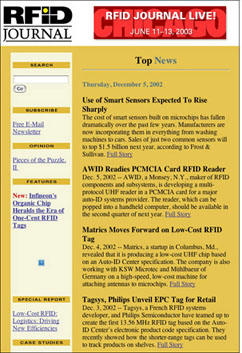Last week, RFID Journal celebrated its third birthday. I founded the company and launched the Web site on March 1, 2002. I don’t have a screen shot of that first day’s Web page, but I found the home page on Dec. 5, 2002, archived on the Web. You can see from the image that accompanies this article that we’ve changed a lot, and so has the RFID industry. I think it’s worth looking back at where we were in March 2002, because it gives you perspective on where we are today.
Back then, the RFID industry was not in its infancy, although it sometimes seems that way. Texas Instruments, Philips Semiconductors, Sokymat and a number of other companies had well-established RFID businesses, selling low-frequency and high-frequency chips. They also had partners who made RFID labels, and there were a small number of systems integrators skilled in deploying RFID systems.
|
|
Savi Technology was providing active tags and software to the U.S. Department of Defense, and a few companies were working on UHF technology, including Intermec, iPico and Matrics (which was bought last year by Symbol). Alien Technology was developing the first Class 1 Electronic Product Code specification with researchers at the Auto-ID Center. (Matrics was not a member at that time.)
I designed RFID Journal’s first site (looks it, doesn’t it?), wrote the code, and researched and wrote all the articles. In those days, there wasn’t much news. In fact, I occasionally wrote about biometrics news just to keep the site fresh every day. The industry was fairly static, but the work being done on EPC technologies and the idea that RFID could be used to track goods in the open supply chain is what drew me to the market.
Still, a lot of things were lacking that would be needed before RFID could be used in the global supply chain. Here are a few of the elements that did not exist back then.
-A UHF air interface protocol standard
-Middleware for filtering RFID data
-Enterprise applications that could use RFID data
-Investment money for startup capital and R&D
-Label makers that could integrate RFID transponders with
bar code labels on a massive scale
-Education and training for installers
There were also no sources of reliable information, which is why I launched RFID Journal. And there were few believers. I had a couple of vendors e-mail me to tell me I was nuts. I had analysts tell me that RFID adoption was “at least ten years away.” I remember an article in Business 2.0 saying that RFID could not be used in the supply chain, because systems would be overwhelmed by the data.
As a businessperson, I tried to give weight to every reason I heard why RFID would never take off. But none of the reasons ever seemed like serious impediments to adoption. Sure we didn’t have all the things listed above, but what we did have, in the form of the Auto-ID Center’s membership, was a group of very large companies that banded together because they saw the value of RFID. I believed that if there were companies that wanted to use RFID in the supply chain, there would be vendors who would jump into the market and create affordable products they could sell to them.
That is precisely what happened. As the elements needed to create a larger RFID industry were coming together, I wrote about the industry’s developments and analyzed its progress in my opinion pieces. The first one appeared on Sept. 16, 2002 (see Pieces of the Puzzle). Looking back, we’ve come a very long way in a very short period of time. The adoption of RFID in the supply chain is happening faster than I ever imagined.
There is, of course, a lot of work still to be done. The technology, as some analysts are fond of pointing out, is far from perfect. Read reliability is not nearly as good as end users would like it to be. Readers are bulky and expensive. Tags don’t always function, and supply is spotty.
But RFID Journal is investing in improving our Web site, magazine and events, because I believe that the RFID industry will change as much—or more—in the next three years as it has in the past three. If end users demand better RFID products—and they are—technology companies will invest in developing better products. This isn’t rocket science. It’s capitalism. And it’s a beautiful thing.
Mark Roberti is the founder and editor of RFID Journal. If you would like to comment on this article, click on the link below.
REMINDER: Our RFID Salary Survey closes March 8. Take the survey and your name will be entered into a lucky draw to win one of three free subscriptions to RFID Journal . The grand prize is free admission to RFID Journal LIVE! 2005, our third annual executive conference being held in Chicago, April 10 to 12. The survey results will be released at the event and we’ll use the responses to create a salary calculator for all our readers to use.


